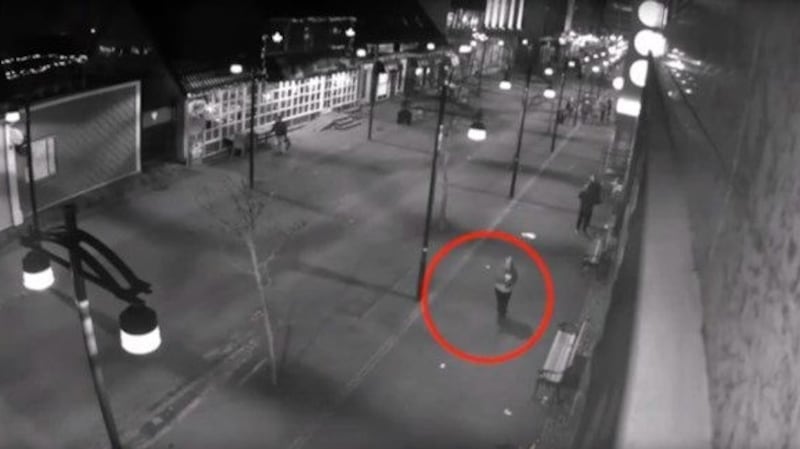There are few places in the world where someone is less likely to be murdered than in Iceland. During the last two decades, an average of about two people have been murdered annually in the small and prosperous nation of 336,000. The country has had entire years – 2003, 2006 and 2008 – where not a single person was murdered. But Iceland, where police officers do not carry firearms, has been shaken by the recent death of Birna Brjansdottir, a fun-loving, 20-year-old sales assistant who worked at a department store in a shopping mall. Her disappearance more than a week ago after last being seen staggering down a street in downtown Reykjavik, prompted the largest search and rescue operation in decades.
On Sunday, the police found Brjansdottir's body on a beach next to a lighthouse about 22 miles southeast of the capital, Reykjavik, and said they were treating the case as a murder. Two sailors from Greenland, ages 25 and 30, have been arrested, but have not been charged with a crime that, for now at least, remains a mystery.
The case has attracted so much attention in Iceland that when police announced on Sunday they had found the body, throngs of distraught onlookers gathered around a large-screen television at the Reykjavik mall where she had worked to watch the news reports.


Bar crawl
Many questions remain unanswered. Why, for example, were Brjansdottir's black Doc Martens found on the docks of a harbour about 25 miles from the beach where her body was found? Why was there snow on their soles on a snowless day? How did traces of her blood get splattered on the seat of a red Kia Rio sedan? And was she sexually assaulted before her death?
The national mystery began on January 14th when Brjansdottir’s mother phoned police in a panic after her daughter failed to return home from a bar crawl in downtown Reykjavik on a foggy night. Surveillance video, released by police, showed Brjansdottir walking unsteadily by herself down a deserted street at around 5 am. At one point, the police said, she could be seen near a red Kia. It was the last time she was seen alive.
As the disappearance dominated news bulletins across the country, about 775 rescue workers volunteered to search for the missing woman, who had distinctive red hair. Icelandic newspapers and television reported that in her last post on Facebook on January 12th, she lamented that it was "two minutes until the worst day of the year", because "Kiss a Ginger Day" – a day of empowerment for redheads – was nearly over and no one had kissed her.
A few days later, after frantically scouring the Icelandic capital and its surrounding areas for clues, the police found her Doc Martens on a dock at Hafnarfjordur, a sleepy town on the outskirts of Reykjavik known for its annual Viking festival, its local rock ‘n’ roll bands and its picturesque lava fields.
After reviewing video from the scene, they noticed something else: A fishing trawler from Greenland, the Polar Nanoq, moored to a nearby dock. Not far from it they spotted a small red car. It was parked there at 6:30 am, the surveillance video showed, and it was the same model as the vehicle seen next to Brjansdottir before she vanished. Tracing the license plate, the police learned that the car had been rented by two men from the trawler.
Viking Swat Team
There was just one problem. The men who were now the prime suspects in Brjansdottir's death could be on the ship, but the Polar Nanoq had set off for Greenland days earlier. Fearful that the suspects would get beyond their reach, the Icelandic Coast Guard sent a helicopter with a squad of six special forces officers, known as the Viking Swat Team, to intercept the vessel, a spokesman for the Icelandic Coast Guard, Sveinn Gudmarsson, said.
About 90 minutes later, Gudmarsson said, the squad – part of the only armed police force in Iceland – rappelled onto the trawler and arrested the two fishermen, who did not resist. He said that the ship was aware “the Vikings” were pursuing them and had already altered course to return to Reykjavik. “The weather was bad and there were eight-metre-high waves,” he said. “The crew cooperated.”
Helgi Gunnlaugsson, a sociology professor at the University of Iceland, said the case had captivated and shocked Icelanders not only because killings were so unusual in Iceland – in 2012 it had the third-lowest murder rate in the world after Liechtenstein and Singapore – but because the suspects were foreigners and the case had seemed such a mystery at first.
Icelanders, for all the lack of violent crime in their homeland, are nevertheless fascinated by it, and crime novelists such as Arnaldur Indridason and Yrsa Sigurdardottir are national treasures. Some Icelanders have drawn parallels between the Brjansdottir case and a popular Icelandic television series called Trapped, centring on an unsolved murder mystery in a remote village where residents are cut off by heavy snow. In the series, a mutilated torso is caught in a fishing net and the suspects are thought to reside on a boat.
“Most murder cases in Iceland are not mysteries – the victims and their killers usually know each other, the murderer rarely seeks to cover up the crime, and cases are usually solved quickly,” Gunnlaugsson said. He added: “Foreign involvement is almost unheard of. The reaction would be different if the suspects would’ve been two Icelandic boys.”
Soul-searching and mourning
The killing has spurred soul-searching and mourning in Greenland, an autonomous territory of Denmark that is geographically part of North America but whose majority Inuit people are deeply influenced by Nordic culture and share a similar island mentality and fishing culture with Iceland.
Over the weekend, about 400 Greenlanders braved chilly weather to attend a memorial outside the Icelandic consulate in Nuuk, the country’s capital. The local pastor led hymns as the crowd laid candles on snow drifts around the consulate. Greenland’s foreign minister sent condolences to his Icelandic counterpart.
"The case has dominated headlines in Nuuk, just as it has in Reykjavik," Petur Asgeirsson, Iceland's consul general in Nuuk, said in an interview. Greenland, which has a population of about 58,000 and is the largest island in the world, has no traditional prisons where prisoners are secured under lock and key.
It has a progressive attitude toward the rehabilitation of criminals. Rather than being locked up, some convicted rapists, paedophiles and murderers are placed in rehabilitation centres and have the opportunity to walk the streets, though the most dangerous are sent to prison in Denmark.
Sigrun Skaftadottir, a 28-year-old DJ in Reykjavik, said the killing of a woman in the prime of her life had spooked Icelanders and was already changing the way people behave, including prompting renewed interest in self-defence classes.
“Girls in my circle are either walking home with someone or taking a taxi, even if they are just travelling a few blocks,” she said. “I can’t stop thinking of all the times I walked home alone in Reykjavik, sometimes drunk, sometimes with music in my ears, engaging with strangers, even inviting random people at the bar to an after-party.”
She added, “Now, I won’t do that again.”
New York Times






















